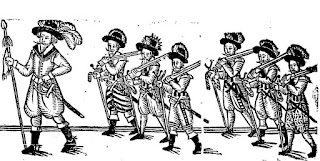William Gordon of Minimore’s Strathavan Highlanders
The best thing about painting highlanders is that when you have finished, you know that you don't have to paint them again. Technically that is true for any figures that you paint, but to be honest I don't actually mind painting harquebusiers. I positively enjoy painting London Trained Band regiments. But not highlanders. I really dislike painting highlanders. I mean I REALLY dislike painting highlanders. It's not like it is just an aversion to painting 'tartan'. They are just all round bloomimg horrible to paint. With their little knees on show; the tricksy billowing folds of their plaid; their 'apostles' hidden amongst it all; not to mention their strange fixation with offal based 'food' products. But I digress.
Colonel William Gordon’s Regiment was raised in Strathavan, a small glen some thirty miles south of Elgin. This branch of the Gordons came from the town of Minimore, near what is now Glenlivet. The Regiment was commanded by Colonel William Gordon and ‘three of his sonnes': presumably the three eldest, Alexander, Patrick and Harry.
Colonel William would be described in Britane's Distemper as "a waliant gentleman, who shew himself a loyal subject of his King, and a faithful and constaint follouer of the house of Huntly in all their expeditions".
I've chosen to go the full on highlander presentation; although records show that they appear to have been quite well equipped and were possibly conventionally equipped with pike and musket.
They were a staple of Montrose's Army, being one of the highland regiments to regularly figure in orders of battle. They would fight at Fyvie, Auldearn, Alford, Kilsyth, and the taking of Aberdeen.
Colonel William would be captured by Middleton's Covenanting troops when Huntly's rising collapsed in 1647: he was sent to Edinburgh where he was imprisoned in the Tolbooth. He was referred to as "an active and bloody Instrument in rebellion". He would be eventually be released in 1649. He would die in 1674.













"The best thing about painting highlanders is that when you have finished, you know that you don't have to paint them again." That made me laugh. And it is true! My Montrose army was one of the first I raised and since then I've moved to a slightly different basing size, so they need rebasing AND I need to repaint the highland units! It's a much postponed chore.
ReplyDeleteI think it is more psychological rather than technical inability tbh. I've hit upon block paint, wash, then add the plaid/tartan lines after washing. Realised I was spending ages painting lines that would be hidden by the wash. Looks fine in real life, just about passes muster magnified on a 'puter screen.
DeleteA top tip that one. Thank you!
Delete